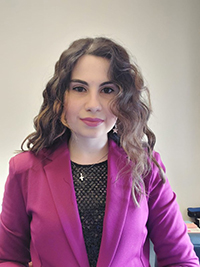SIUE and ISU Researchers Tackle Drinking Water Safety Across Illinois
 An SIUE-led research team is taking a statewide look at what lingers in the tap—measuring and mapping potential contaminants in Illinois drinking water using advanced chemical and geospatial analysis. The initiative, “Sustaining Illinois through Safe Drinking Water for All: A Detailed Chemical and Geospatial Analysis of Agricultural and Pharmaceutical Contaminates in Drinking Water Across Illinois” brings together faculty and students from Southern Illinois University Edwardsville and Illinois State University.
An SIUE-led research team is taking a statewide look at what lingers in the tap—measuring and mapping potential contaminants in Illinois drinking water using advanced chemical and geospatial analysis. The initiative, “Sustaining Illinois through Safe Drinking Water for All: A Detailed Chemical and Geospatial Analysis of Agricultural and Pharmaceutical Contaminates in Drinking Water Across Illinois” brings together faculty and students from Southern Illinois University Edwardsville and Illinois State University.
Milena Di Blasi, a recent graduate of SIUE’s biochemistry program (’25), and her research mentor, Carrie Butts-Wilmsmeyer, PhD, director of the Center for Predictive Analytics and associate professor of Biological Sciences, are leading the project. The team is analyzing 250 water samples collected from all Illinois counties to detect endocrine disrupting compounds (EDCs), a class of chemicals that includes certain estrogenic compounds and pesticides known to persist even after standard water treatment processes.
"Every water sample we analyze represents a real home, a real family, a real community,” said Di Blasi. “My hope is that this research will help us design better treatment systems, guide local decision-makers, and develop rapid testing tools—because protecting water means protecting life."
Funded through a competitive $40,000 seed grant from the Illinois Innovation Network (IIN), and an additional $13,000 from SIUE’s Center for Predictive Analytics (C-PAN) to support student involvement and expand research capacity, the project of the first of its kind.
“Until recently, our scientific instrumentation was not sensitive enough to detect a variety of EDC contaminates if they were below a certain concentration, so it is not standard protocol to monitor drinking water for many EDCs,” said Butts-Wilmsmeyer. “However, long-term exposure to certain endocrine disrupting compounds may pose risks to human health, even at very low concentrations. This is the first time that the concentration of suspected EDC drinking water contaminants has been mapped across the entirety of Illinois, not just at a handful of facilities. We now truly have an understanding of the relative risk these compounds pose across the state.”
Samples are being analyzed at SIUE’s Shimadzu SPARQ Laboratory using liquid and gas chromatography-mass spectroscopy techniques, with advanced geospatial analysis conducted in partnership with SIUE’s Geospatial Mapping Applications Research Center, (GeoMarc). The data will be used to create a statewide map of contaminant concentrations and to predict concentrations in communities that were not sampled based on the underlying water network infrastructure.
Field days and community outreach efforts will be coordinated by Nicholas Heller, PhD, associate professor of crop sciences at ISU. The team is committed to sharing findings with farmers, local government officials and the broader public. The project also includes contributions from SIUE’s Kevin Tucker, PhD, associate professor of chemistry, as well as several student researchers from both institutions.
Butts-Wilmsmeyer brings extensive experience in environmental monitoring and geospatial research. Her current work includes mapping mycotoxin contamination in grain crops, and she previously collaborated on projects related to agricultural runoff, water quality and remote sensing. In 2022, she was honored as SIUE’s Vaughn Vandegrift Undergraduate Research and Creative Activities Mentor.
“This has been a truly collaborative effort,” she said. “We’re already seeing possibilities to take the work further, and we hope this foundation will support future research into water quality, mitigation strategies tailored to each community’s needs, and environmental health across Illinois.”
This work aligns with the broader goals of the IIN to promote collaborative, community-centered research across institutions. It started as a suggestion from Butts-Wilmsmeyer’s undergraduate student, Milena Di Blasi.
“It’s been a joy to work with a cross-institutional team on a project that truly matters,” Butts Wilmsmeyer concluded. “To see it sparked by a student’s curiosity and then to have the pleasure of mentoring that student while she brought her research ideas to reality—that is something truly special.”
As data transforms into maps, models and public engagement, the team’s vision remains clear: clean water for every community—measured, mapped and made possible through science.

PHOTO: Top: Milena Di Blasi, bottom, left to right: Josh Pritsolas, Randy Pearson, Carrie Butts-Wilmsmeyer, Nicholas Heller, Kevin Tucker










